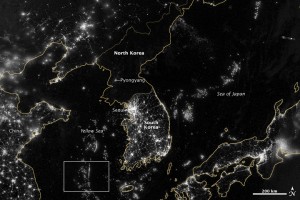Eric T. passes along this amazing satellite photo of the Korean peninsula taken at night on 2012-9-24:
The photo comes from NASA. Click image to see larger version.
When I get some time (maybe this weekend) I will see if I can put names to the lights in North Korea.
Here is the text from the NASA web page:
City lights at night are a fairly reliable indicator of where people live. But this isn’t always the case, and the Korean Peninsula shows why. As of July 2012, South Korea’s population was estimated at roughly 49 million people, and North Korea’s population was estimated at about half that number. But where South Korea is gleaming with city lights, North Korea has hardly any lights at all—just a faint glimmer around Pyongyang.
On September 24, 2012, the Visible Infrared Imaging Radiometer Suite (VIIRS) on the Suomi NPP satellite captured this nighttime view of the Korean Peninsula. This imagery is from the VIIRS “day-night band,” which detects light in a range of wavelengths from green to near-infrared and uses filtering techniques to observe signals such as gas flares, auroras, wildfires, city lights, and reflected moonlight.
The wide-area image shows the Korean Peninsula, parts of China and Japan, the Yellow Sea, and the Sea of Japan. The white inset box encloses an area showing ship lights in the Yellow Sea. Many of the ships form a line, as if assembling along a watery border.
Following the 1953 armistice ending the Korean War, per-capita income in South Korea rose to about 17 times the per-capital income level of North Korea, according to the U.S. Central Intelligence Agency. Worldwide, South Korea ranks 12th in electricity production, and 10th in electricity consumption, per 2011 estimates. North Korea ranks 71st in electricity production, and 73rd in electricity consumption, per 2009 estimates.


Wouldn’t we still expect more lights than that for a country that’s 73rd (presumably about of almost 200) in electricity consumption? What’s going on?
If you go to http://earthobservatory.nasa.gov/NaturalHazards/view.php?id=79796
you will see under the lower image that there is a KML version of the image which you can download and save, and then open in GoogleEarth. This superimposes the night image on the GE coverage of North Korea after you click the box of the file in My Places. Just below that is a slider to adjust the opacity. You will be surprised how many dimly lighted cities and and fishing fleets show up as you zoom in. North Korea is not as ‘lightless’ as commonly believed.
Ah, thanks – that explains it. When I zoom in, it’s clear that most of North Korea has about as much light as the more rural parts of South Korea and China (putting borders on the map actually plays a bit of a trick on the eyes, creating a division between North Korea and China that’s not nearly as noticeable from the lights alone).
(moving comment to better location below)
They can launch a satellite but can’t supply basic needs to their fellow citizens.
This city lights at night are reliable indicator only that South Korea waste unnecessary huge amounts of energy. It’s no wonder that South Korea consumes 22 times more electricity than North Korea, and only about 1% of this electricity is from renewables, while in North Korea’s the share of renewables is about 60%. South Korea energy imports are 242 Mtoe/year compared to only 0,9 Mtoe/y imports of NK (250 times less). South Korea is also hundreds times greater source of harmful emissions than NK. In the same time housing,health and education are free in NK and the prices of electricity and heating are symbolic.